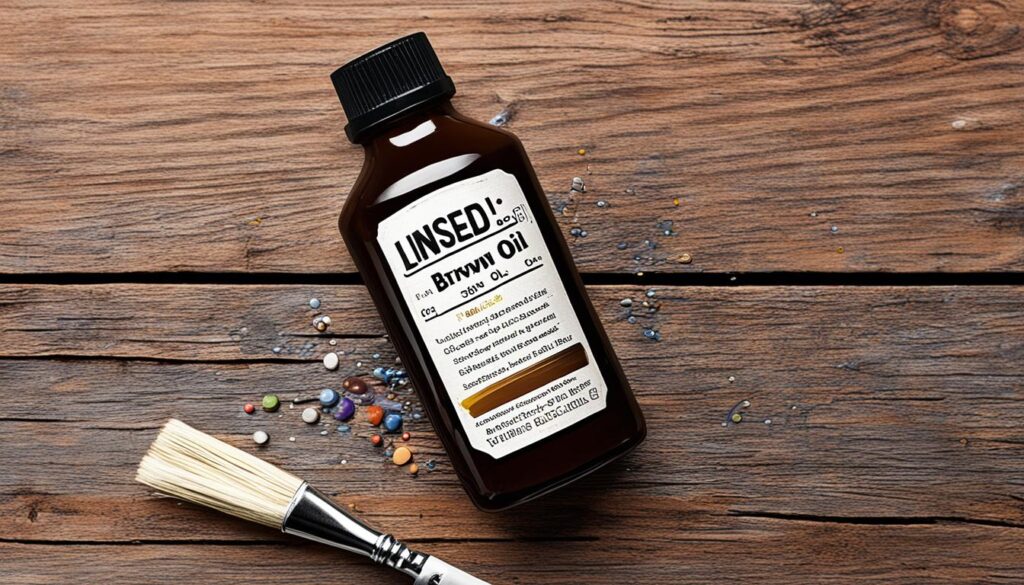Linseed oil’s toxicity and safety are dependent on its form and application. Raw linseed oil, high in alpha-linolenic acid (ALA), is generally non-toxic and safe for consumption but may cause gastrointestinal irritation in large amounts. Boiled linseed oil contains metallic drying agents, making it toxic if ingested and hazardous due to spontaneous combustion risks. In both forms, proper handling and ventilation are crucial to prevent allergic reactions and fire hazards. For those using linseed oil in artistic or culinary applications, specific guidelines should be followed to guarantee safety and effectiveness. Further details reveal its diverse applications and safety measures.
Understanding the Composition of Linseed Oil
Understanding the composition of linseed oil involves a detailed analysis of its primary fatty acids, primarily found fatty acids, minor bioactive components, and their respective contributions to its physical and chemical properties.
Linseed oil, also known as flaxseed oil, mainly contains alpha-linolenic acid (ALA), comprising 48-60% of its fatty acid profile. This high concentration of ALA, an omega-3 fatty acid, is essential for its nutritional value and drying properties, making it suitable for both edible applications and industrial uses such as in paints and varnishes.
Additional fatty acids in linseed oil include linoleic acid (11-19%), oleic acid (14-27%), palmitic acid (5-7%), and stearic acid (3-5%). These components contribute to its overall stability and functionality. Linseed oil also contains bioactive compounds like carotenoids, tocopherols (particularly γ-tocopherol), and phenolic compounds, which enhance its antioxidant properties and safety profile.
Raw linseed oil is non-toxic and safe for consumption, often used as a dietary supplement. However, boiled linseed oil, which contains added metallic driers, is hazardous if ingested and is not edible. Polymerized linseed oil, modified for specific industrial applications, also requires careful handling.
Despite these variations, linseed oil remains a versatile and valuable substance across different domains.
Exploring the Toxicity Levels of Linseed Oil
Evaluating the toxicity levels of linseed oil requires a thorough understanding of its different compositions, especially the variances between raw and boiled forms. Raw linseed oil, known for its high omega-3 content, is generally non-toxic and safe for consumption in moderation. According to Material Safety Data Sheets (MSDS), raw linseed oil poses minimal health risks. However, large amounts may cause gastrointestinal irritation upon ingestion. Additionally, it is not classified as acutely toxic, nor does it cause significant irritation or damage to skin or eyes upon contact.
Conversely, boiled linseed oil, commonly used for wood finishes, contains metallic drying agents that render it inedible and potentially toxic if ingested. The ingestion of boiled linseed oil can lead to gastrointestinal irritation and severe respiratory issues, such as chemical pneumonitis, if aspirated into the lungs. It is categorized as an acute toxicity hazard, capable of causing skin and respiratory tract irritation upon contact.
Both forms of linseed oil pose a significant fire hazard due to the risk of spontaneous combustion of oil-soaked materials. Proper disposal and ventilation are essential to mitigate this risk. Additionally, both forms can cause allergic reactions and irritation in sensitive individuals, necessitating careful handling.
is linseed oil toxic
While raw linseed oil is generally non-toxic and safe for consumption in moderate amounts, the boiled variant contains metallic drying agents that render it potentially hazardous if ingested. Raw linseed oil, rich in omega-3 fatty acids, is often used as a dietary supplement. However, its ingestion in large quantities may lead to gastrointestinal irritation.
Boiled linseed oil, commonly utilized in furniture refinishing, poses more significant risks due to the presence of metallic driers, which can cause severe gastrointestinal and respiratory irritation if ingested or inhaled.
Furthermore, both raw and boiled linseed oil can lead to skin irritation and allergic reactions upon contact.
Another critical concern is the flammability of linseed oil. Rags or materials soaked with linseed oil can undergo spontaneous heating, leading to spontaneous combustion if not disposed of properly.
Proper ventilation during the drying process is essential to mitigate the release of unpleasant odors and reduce the risk of respiratory irritation.
Safe Handling and Use of Linseed Oil
To guarantee the safe handling and use of linseed oil, it is essential to implement appropriate personal protective equipment (PPE) and adhere to recommended storage and disposal practices. Wearing safety goggles or glasses with side shields and chemical-resistant gloves is vital to prevent contact with skin and eyes. Although linseed oil is biodegradable and generally considered safe, improper handling can lead to side effects such as skin irritation or allergic reactions.
Adequate ventilation is necessary to mitigate any inhalation risks and to disperse unpleasant odors released during the oxidation process. When used as a dietary supplement, raw linseed oil, high in antioxidants, poses minimal health risks; however, boiled linseed oil with added driers should not be ingested.
From a regulatory compliance perspective, adherence to OSHA guidelines is mandatory. Proper storage in a cool, well-ventilated area, away from strong oxidizers, is recommended. Disposal of linseed oil and any contaminated materials should be conducted at hazardous waste collection points to prevent environmental contamination.
For spill Clean-up, use inert absorbent materials like sand or vermiculite, avoiding combustible materials such as sawdust to prevent fire hazards. Awareness and caution are paramount to ensuring the safe use of linseed oil.
Linseed Oil in Artistic Applications
Recognizing the importance of proper handling and safety measures, linseed oil‘s role in artistic applications, particularly in oil painting, leverages its unique properties to enhance the artist’s medium.
Linseed oil, especially refined and cold-pressed variants, is pivotal in modifying drying time, increasing gloss, and enhancing transparency. This allows artists to maintain the workability of their paint layers, essential for complex, layered techniques.
While raw linseed oil is non-toxic, the potential for skin irritation and allergic reactions necessitates caution. Proper ventilation is crucial due to the odor released during the drying process, and this ensures a safer working environment. Additionally, the disposal of rags soaked in linseed oil must be handled meticulously to prevent spontaneous combustion, a significant safety hazard.
The solvent-free nature of linseed oil makes it a preferable medium, but it can be mixed with turpentine or odorless mineral spirits to adjust the drying rate and consistency. Adhering to the ‘fat over lean‘ rule, where slower-drying layers are applied over faster-drying ones, prevents cracking and ensures the longevity of the artwork.
Linseed Oil in Culinary and Health Applications
Linseed oil, known for its high alpha-linolenic acid (ALA) content, serves as a valuable dietary supplement and culinary ingredient due to its potential health benefits and nutritional profile. Its culinary uses are diverse, though it is unsuitable for high-heat cooking owing to its low smoke point of approximately 225°F (107°C).
Instead, linseed oil excels as a finishing oil in dressings, dips, and even as a drizzle over grains and vegetables. It also pairs well with traditional European dishes such as boiled potatoes and quark.
The health benefits of linseed oil are mainly attributed to its rich omega-3 fatty acid content, particularly ALA. Each tablespoon provides over 7 grams of ALA, which has been associated with reduced inflammation, improved heart health, and better blood sugar control. Additionally, linseed oil contains antioxidants like lignans, which may offer additional health benefits.
From a safety perspective, raw linseed oil is generally considered non-toxic and safe for moderate consumption. However, improper handling can lead to issues like spontaneous combustion of soaked rags. Additionally, individuals may experience allergic reactions or digestive issues such as loose stools if consumed excessively. Proper handling and moderation are hence essential.
Welcome to WoodCraftYard.com, your one-stop destination for all things woodworking! I’m Oliver Candler, a dedicated woodworking aficionado and the creative mind behind this virtual woodworking haven. With a deep-rooted love for craftsmanship and a keen eye for detail, I am on a mission to share my passion for woodworking with fellow enthusiasts like yourself.
As a seasoned woodworker, I am committed to providing you with valuable insights, practical tips, and inspiring project ideas to help you unleash your creativity and master the art of woodworking. Whether you’re a seasoned pro or just starting out on your woodworking journey, join me as we carve, sand, and saw our way through the world of woodworking together.
Let’s embark on this woodworking adventure, where every knot, grain, and finish tells a unique story. Together, let’s craft, create, and build something truly extraordinary at WoodCraftYard.com!


